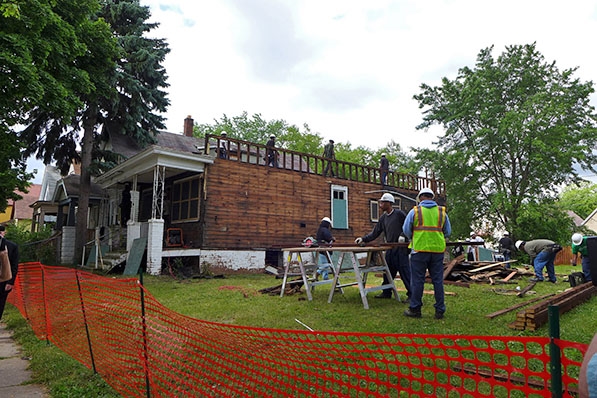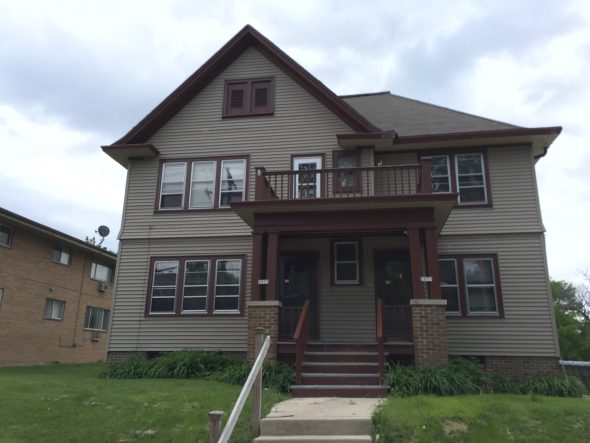The Problems with Deconstruction
New city program is promising, but also faces obstacles.
In the beginning of 2018, two Milwaukee alderman brought forth a new ordinance that would change the rules in the city for building demolition, and they hoped, create new jobs for residents that need them most.
Now, with the rules starting to kick in at projects around the city and bids starting to come in for public projects, Ald. Bob Bauman, whose brainchild the ordinance was, is feeling the blows as the program runs into some unexpected obstacles.
The ordinance itself requires that when buildings built before 1929 are taken down they be deconstructed, as opposed to mechanically demolished with heavy equipment, and that materials be salvaged and reused instead being sent to the dump.
The ordinance should, in theory, salvage historic building materials and save on fees the city pays for dumping. But of chief importance to the alderman who sponsored the legislation, Bauman and Ald. Nik Kovac, it would create jobs for unemployed or underemployed city residents through the city’s workforce requirements.
There are a number of city-owned buildings with raze orders that meet the requirement, and are open for bidding from contractors working in deconstruction. But right now, those bids are too high, and not meeting city workforce requirements. And this is imperiling the program before it really gets off the ground.
Only last week deconstruction started on the first building in the city to be demolished since the ordinance was passed. It was a private building on N. Cambridge Avenue. It was being deconstructed by a firm out of Pleasant Prairie called Recyclean. And Bauman told the owner Mike Goffman, “Unless we get bids coming in that are reasonable, my colleagues will scrap this.”
A market for these materials has not yet been firmly established in the city. For example, starting a viable resale yard for these materials would require a dependable supply of product, Bauman said, and that’s not there yet. And none of the bids have met the hiring requirements of the city. Even with the pricey bids the city is getting, none of them have plans to hire and train enough unemployed or underemployed city residents, Bauman said.
“And we’re having a problem, with all due respect to these guys (Recyclean), finding contractors that are willing to do deconstructions,” Bauman lamented.
Goffman has been doing deconstruction for more than 20 years, all for private homes. The costs for projects are obviously variable, and he said that things like access to the structure can change a bid price. If there’s easy access on several sides, that can lower a bid, the same way limited access can raise a bid.
Asked what he thought would make the city’s program run smoother, Goffman said help in the form of payroll for training workers. The training is expensive, he said.
“If we had a little bit of help from the city on their programs on subsidizing some of the training, in 90 days we could have somebody up and doing a lot of the activities that take a lot of the labor and have one or two of the foreman specialize,” Goffman explained.
Bauman said he has heard the argument before, saying, “That’s the challenge of job creation that we hear every time — ‘We can’t employ low-income, ex-offenders because we have to train them and that’s costly.’”
In a few weeks, Goffman thinks he can train up some workers, which could allow him to make the bids to the city more efficient. Right now, most of his employees are highly skilled, like the foreman. And 60 percent of the work on a deconstruction project is general labor. Training up a round of laborers will allow the highly skilled workers to spread out to other projects. Which will bring the cost down, because a huge cost for deconstruction is simply time.
A regular mechanical demolition that uses heavy equipment to take a house apart, destroying everything inside, can be completed inside of week. For a deconstruction, Goffman has an equation. It takes roughly 1.5 to 2.25 hours per square foot to complete a deconstruction. So for something like your average two-story duplex, deconstruction takes roughly eight weeks.
In theory, the ordinance will be more efficient initially for private building owners. Because they can deduct the salvaged materials as a charitable contribution, negating some of the increased cost to deconstruct. And Bauman hopes that once a salvage market is humming along in Milwaukee, the city will start to see some savings on deconstruction.
Bauman isn’t wavering in his commitment to the goals and ideals of the program, but noted that “unless we get these bids in line, all that goes away.”
Bauman called this program a case study in the obstacles confronted by attempts to create jobs. “If every time you try to create jobs for the folks most in need and the folks you want to keep off the street and keep out of the criminal justice system, if there’s a million obstacles put up, we’re sunk. We’ll never solve the problem.”
What also weighs on Bauman’s mind is that, in central city neighborhoods, when the city demolishes a house, there is little to be gained. In a neighborhood with strong property values, land can be repurposed for a higher and better use, maybe more money for the tax rolls.
But “not at 25th and Locust,” he notes. There, when the house is gone, all that will remain is an empty lot. There are no developers waiting. Whereas, with the deconstruction program, “at least the act of destruction has created some social good,” he says. Materials can be salvaged, and maybe a few neighborhood residents can get trained in a new skill.
Abandoned homes, foreclosures, then vacant lots, shrinking housing stock, declining neighborhood population. These are all the downstream effects Bauman can’t seem to stop thinking about.
You have “block after block of all these vacant properties,” he notes. “Then people drive through and say ‘well, I don’t want to live in this neighborhood.’ Property values go down, because people can’t sell their houses. People can’t get a home equity loan to fix their roof because they have no equity left. It’s a spiraling problem. You gotta try to stop it at places, stop the bleeding and try to start forward motion.”
Which is why he is still holding out hopes for the deconstruction program.
If you think stories like this are important, become a member of Urban Milwaukee and help support real independent journalism. Plus you get some cool added benefits, all detailed here.





















There’s probably a million reasons, rules, and regs as to why the following suggestions won’t work, but here goes:
1) Reduce the requirement or clearly identify a smaller list of what should be saved or salvaged. Focus on the top 20% of what has actual resale value and keep updating/adjusting that list as needed. Maybe have an architectural expert work with a resale professional to keep that list up to date. Saving everything may result in saving nothing.
2) After step 1, let the scrappers at the place. The city is full of these industrious entrepreneurs. Start a list of them and award each house by lottery. Give them a list of ex-offenders to hire for help, otherwise, don’t load them down with insurance and hiring requirements. Maybe, at min, help them with a bond to protect the neighbors from damages.
3) knock down and haul away what’s left.
I like the concept of this effort. I hope it succeeds.
Years back, I saw reports that houses being demolished for returning the river watershed along S. 6th Street and W. Cleveland Avenue were, in some cases, costing upwards of $65,000 per house to remove and recycle them. I cannot imagine building a new house in the City of Milwaukee when the cost of the lot, plus $65,000 before you would even start construction on an old lot. Maybe a million dollar firm will be willing to pay that added cost, but to be that much money in the hole to start sure will make people and small business think twice about building in Milwaukee. This will just create more urban sprawl to the suburbs, where empty land is way WAY cheaper. Not to mention, the City of Milwaukee (taxpayer) could end up paying for any house the City condemns or takes over ownership if someone just abandons it because of this added cost–or “subsidizes” part of that cost to give the land away to a buyer to lure them to build here.